Wikipedia:Picture of the day/December 2022
|
Featured picture tools: |
These featured pictures, as scheduled below, appeared as the picture of the day (POTD) on the English Wikipedia's Main Page in December 2022. Individual sections for each day on this page can be linked to with the day number as the anchor name (e.g. [[Wikipedia:Picture of the day/December 2022#1]] for December 1).
You can add an automatically updating POTD template to your user page using {{Pic of the day}} (version with blurb) or {{POTD}} (version without blurb). For instructions on how to make custom POTD layouts, see Wikipedia:Picture of the day.
December 1

|
|
The red-bellied piranha (Pygocentrus nattereri), also known as the red piranha, is a species of piranha native to South America, found in the Amazon, Paraguay, Paraná and Essequibo basins, as well as the coastal rivers of northeastern Brazil. They are omnivorous foragers and feed on insects, worms, crustaceans, and fish. Red-bellied piranhas often travel in shoals as a predatory defense but rarely exhibit group hunting behavior. Acoustic communication is common and is sometimes exhibited along with aggressive behaviors. They are also often kept as an aquarium species. This fish was photographed at Karlsruhe Zoo in Germany. Photograph credit: H. Zell
Recently featured: |
December 2

|
A Bézier curve is a parametric curve used in computer graphics and related fields. The curve, which is related to the Bernstein polynomial, is named after Pierre Bézier, who used it in the 1960s for designing curves for the bodywork of Renault cars. Other uses include the design of computer fonts and animation. Bézier curves can be combined to form a Bézier spline, or generalized to higher dimensions to form Bézier surfaces. Animation credit: Phil Tregoning
Recently featured: |
December 3

|
The New Mexico Territory was an organized incorporated territory of the United States from September 9, 1850, until January 6, 1912. This illustration, created by Henry Mitchell for State Arms of the Union, published by Louis Prang in 1876, depicts the territory's coat of arms, adopted by legislation in 1887: "The coat of arms of the territory of New Mexico shall be the Mexican Eagle grasping a serpent in its beak, the cactus in its talons, shielded by the American eagle with outspread wings, and grasping arrows in its talons." The year 1850, representing the territory's organization, appears in Roman numerals under the eagles, and below the shield is the Latin motto Crescit eundo ('It grows as it goes'). Illustration credit: Henry Mitchell; restored by Andrew Shiva
Recently featured: |
December 4
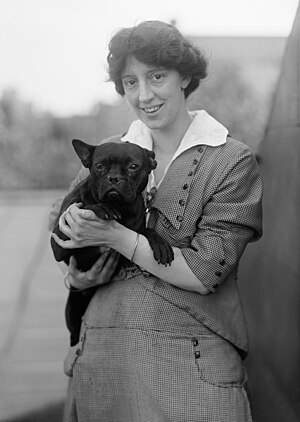
|
Hazel MacKaye (1880–1944) was an American theater professional and suffragist. She is best known for helping present a series of pageants in support of women's suffrage. The organizers of the Woman Suffrage Procession, planned for March 3, 1913 (just prior to President Woodrow Wilson's inauguration), in Washington, D.C., asked MacKaye to create a pageant for the event. Titled Allegory and produced by Glenna Smith Tinnin, it was presented on the steps of the Treasury Building as the culmination of the event. The pageant was praised as "one of the most impressively beautiful spectacles ever staged in this country" in The New York Times. This photograph of MacKaye holding a dog was taken in 1915 by the photographic studio Harris & Ewing. Photograph credit: Harris & Ewing; restored by Adam Cuerden
Recently featured: |
December 5
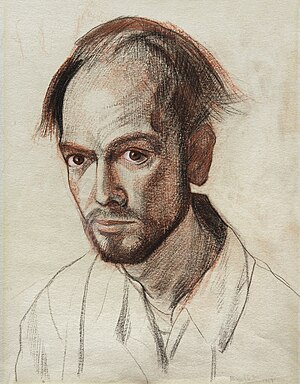
|
William Utermohlen (December 5, 1933 – March 21, 2007) was an American figurative artist who became known posthumously for his self-portraits created after his diagnosis of Alzheimer's disease. He had developed progressive memory loss beginning about four years before his diagnosis in 1995. During that time, he began a series of self-portraits influenced in part by the figurative painter Francis Bacon and cinematographers from the movement of German Expressionism. Utermohlen created this self-portrait with mixed media on paper in 1967. Illustration credit: William Utermohlen
Recently featured: |
December 6

|
|
The marabou stork (Leptoptilos crumenifer) is a large species of wading bird in the stork family, Ciconiidae. Breeding in sub-Saharan Africa, it eats mainly carrion, scraps and faeces, but will opportunistically eat almost any animal matter it can swallow. It occasionally eats other birds including Quelea nestlings, pigeons and doves, pelican and cormorant chicks, and even flamingos. During the breeding season, adults scale back on carrion and take mostly small, live prey since nestlings need this kind of food to survive. Common prey at this time may consist of fish, frogs, insects, eggs, small mammals and reptiles such as crocodile hatchlings and eggs. Though known to eat putrid and seemingly inedible foods, these storks may sometimes wash food in water to remove soil. Increasingly, marabous have become dependent on human garbage and hundreds of the birds can be found around African dumps or waiting for a handout in urban areas. Those eating garbage have been seen to devour virtually anything that they can swallow, including shoes and pieces of metal, and those conditioned to eating from human sources have been known to lash out when refused food. This marabou stork was photographed in Queen Elizabeth National Park in southwestern Uganda. Photograph credit: Charles J. Sharp
Recently featured: |
December 7

|
|
Let Kunovice, operating as Let, n.p., is a Czech (before December 1993 Czechoslovak) civil aircraft manufacturer. Its most successful design has been the L-410 Turbolet, of which more than 1300 units have been built (an upgraded version, the L-410 NG, is pictured here). Its head office is in Kunovice, Uherské Hradiště District. Let was owned by the Russian company UGMK from 2008 to 2022, when it was acquired by Czech-based Omnipol Group. Photograph credit: Julian Herzog
Recently featured: |
December 8

|
|
Orpheus in the Underworld is a comic opera composed by Jacques Offenbach with a French-language libretto by Hector Crémieux and Ludovic Halévy. It was first performed as a two-act opéra bouffon at the Théâtre des Bouffes-Parisiens, Paris, in 1858, and was extensively revised and expanded in a four-act opéra féerie version, presented at the Théâtre de la Gaîté in 1874. The plot is a lampoon of the myth of Orpheus and Eurydice in Greek mythology. In this version, Orpheus is not the son of Apollo but a rustic violin teacher. He is glad to be rid of his wife Eurydice when she is abducted by Pluto, the god of the underworld. Orpheus has to be bullied by Public Opinion into trying to rescue Eurydice. The reprehensible conduct of the gods of Olympus in the opera was widely seen as a veiled satire of the court and government of French emperor Napoleon III. This photograph depicts Jeanne Granier as Eurydice and Eugène Vauthier as Jupiter in the form of a fly as part of the 1887 Paris revival of Orpheus in the Underworld. Photograph credit: Atelier Nadar; restored by Adam Cuerden
Recently featured: |
December 9
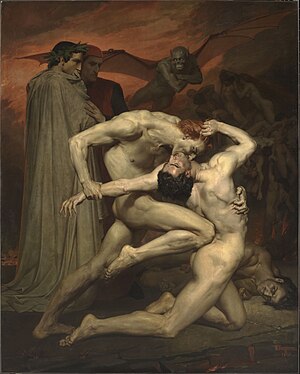
|
The Divine Comedy is an Italian narrative poem by Dante Alighieri, begun around 1308 and completed in around 1321, shortly before the author's death. The poem's imaginative vision of the afterlife is representative of the medieval worldview as it existed in the Western Church by the 14th century. It helped establish the Tuscan dialect, in which it is written, as the standardized Italian language. It is divided into three parts: Inferno, Purgatorio and Paradiso. The subject of the narrative is the state of the soul after death and presents an image of divine justice meted out as due punishment or reward. In the poem, Dante travels through Hell, Purgatory and Heaven, and is accompanied by three guides: the Roman poet Virgil (who accompanies him for all of Hell and most of Purgatory), Dante's muse Beatrice (at the end of Purgatory and for most of Heaven) and Saint Bernard of Clairvaux (who guides him in the final cantos of Heaven). This oil-on-canvas painting, titled Dante and Virgil and completed by the French artist William-Adolphe Bouguereau in 1850, depicts Dante with Virgil observing two damned souls in eternal combat in Hell. Capocchio, an alchemist and heretic, is being bitten on the neck by the trickster Gianni Schicchi, who had used fraud to claim another man's inheritance. The painting now hangs in the Musée d'Orsay in Paris. Painting credit: William-Adolphe Bouguereau
Recently featured: |
December 10

|
|
The lilac-breasted roller (Coracias caudatus) is a species of bird in the roller family, Coraciidae. It is widely distributed in sub-Saharan Africa, and is a vagrant to the southern Arabian Peninsula. It prefers open woodland and savanna, and it is for the most part absent from treeless places. Usually found alone or in pairs, it perches at the tops of trees, poles or other high vantage points from where it can spot insects, amphibians, crabs and small birds moving about on the ground. Nesting takes place in a natural hole in a tree where a clutch of two to four eggs are laid, and incubated by both parents, who are extremely aggressive in defence of their nest, taking on raptors and other birds. This lilac-breasted roller, of the subspecies C. c. caudatus, was photographed perching on a branch in Chobe National Park, Botswana. Photograph credit: Charles J. Sharp
Recently featured: |
December 11
|
In ecology, crypsis is the ability of an animal or a plant to avoid observation or detection by other animals. It may be a predation strategy or an anti-predator adaptation. Methods include camouflage, nocturnality, subterranean lifestyle and mimicry. Crypsis can involve visual, olfactory (with pheromones), or auditory concealment. When it is visual, the term cryptic coloration, effectively a synonym for animal camouflage, is sometimes used, but many different methods are employed by animals or plants. These photographs, captured in Montagne d'Ambre National Park, Madagascar, depict a mossy leaf-tailed gecko (Uroplatus sikorae) exhibiting crypsis by camouflaging itself on a branch (above), and revealing itself from its camouflage (below). Photograph credit: Charles J. Sharp
Recently featured: |
December 12
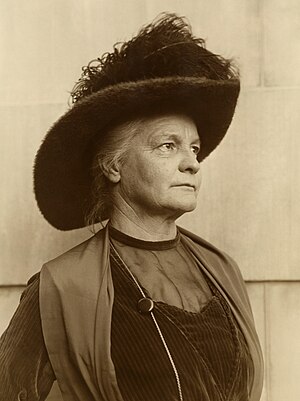
|
Elizabeth Glendower Evans (February 28, 1856 – December 12, 1937) was an American social reformer and suffragist. She pursued social reform, serving in a variety of positions, including as a delegate to the International Congress of Women at the Hague in 1915, the first national organizer of the Woman's Peace Party, and a national director of the American Civil Liberties Union. This photograph, from the library of The Washington Times, depicts Evans wearing a large feathered hat. The image was published in an issue of The Suffragist in 1914. Photograph credit: The Washington Times; restored and cropped by Adam Cuerden
Recently featured: |
December 13

|
|
Project Riese was the code name for an unfinished construction project undertaken by Nazi Germany between 1943 and 1945. It consisted of seven underground structures in the Owl Mountains and Książ Castle – pictured here – in Lower Silesia (now part of Poland). The purpose of the project remains uncertain because of a lack of documentation. Some sources suggest that all the structures were part of the Führer Headquarters; according to others, it was a combination of headquarters and arms industry, but comparison to similar facilities can indicate that only the castle was adapted as a headquarters or official residence, and the tunnels in the Owl Mountains were planned as a network of underground factories. Photograph credit: Jarosław Ciuruś
Recently featured: |
December 14

|
|
Pittsburgh is a city in the southwest of the US state of Pennsylvania, located at the confluence of the Allegheny and Monongahela rivers, which combine to form the Ohio River. It had a population of 302,971 as of the 2020 census, and is the anchor of the Pittsburgh metropolitan area, the second-largest in the state with a population of 2.37 million. Pittsburgh is known as the "Steel City", as a result of its more than 300 steel-related businesses and also the "City of Bridges", for its 446 bridges. Named in 1758 in honor of British statesman William Pitt, the city developed as a vital link of the Atlantic coast and Midwest, as the mineral-rich Allegheny Mountains led to the region being contested by the French and British empires, Virginians, Whiskey Rebels, and Civil War raiders. This picture shows a skyline panorama of Pittsburgh at night, taken from Mount Washington. Photograph credit: Dllu
Recently featured: |
December 15
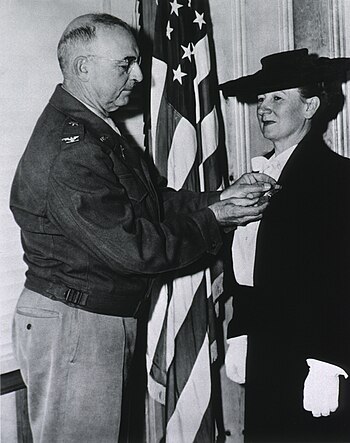
|
Beulah Ream Allen (January 26, 1897 – March 17, 1989) was an American nurse and physician. During World War II, she volunteered as a civilian surgeon for the United States Army and was stationed in Baguio, where she was responsible for the care of nearly 30 soldiers, while the rest of the Army retreated to the Bataan Peninsula. Taken prisoner in 1941, she was held in three internment camps before being liberated. Returning to the United States, she resumed her practice in the Bay Area. In 1960, she moved her practice to Provo, Utah, where she served as the dean of the Brigham Young University College of Nursing until 1964. Allen retired in 1979 and in that year married and relocated to Mesa, Arizona, where she lived until her death in 1989. This photographs shows Allen being awarded the Medal of Freedom in 1946 for her service. Photograph credit: unknown; restored by Adam Cuerden
Recently featured: |
December 16
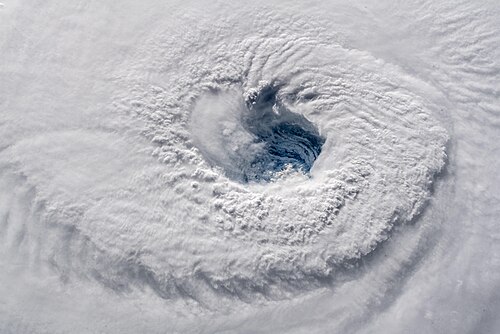
|
|
The eye is a region of mostly calm weather at the center of a tropical cyclone. It is roughly circular, and is typically 30 to 65 kilometers (19 to 40 miles) in diameter. The eye is surrounded by the eyewall, a ring of towering thunderstorms where the most severe weather and highest winds of the storm occur. In strong tropical cyclones, the eye is characterized by light winds and clear skies, surrounded on all sides by a towering, symmetric eyewall, while in weaker storms, it is less well defined and may be covered by a central dense overcast. Weaker or disorganized storms may also feature an eyewall that does not completely encircle the eye or have an eye that features heavy rain. In all storms, however, the eye is the location of the storm's minimum barometric pressure; this can be as much as 15 percent lower than the pressure outside the storm. This photograph, taken by the German astronaut Alexander Gerst from the International Space Station in September 2018, shows the well-defined eye of Hurricane Florence in the Atlantic Ocean. Photograph credit: Alexander Gerst
Recently featured: |
December 17

|
Buddy Hield (born December 17, 1992) is a Bahamian basketball player who currently plays for the Indiana Pacers in the National Basketball Association. Recruited to play college basketball for the Oklahoma Sooners, Hield went on to win the John R. Wooden Award in his senior year as the best college basketball player for the 2015–16 season, in which he averaged 25 points, 5.7 rebounds and two assists per game. He was selected by the New Orleans Pelicans in the 2016 NBA draft as the sixth overall pick, before moving to the Sacramento Kings in early 2017 following a trade. After five years in Sacramento, he joined the Pacers in 2022 in another trade deal. This photograph, taken in January 2016, shows Hield playing for the Oklahoma Sooners against the Texas Tech Red Raiders at the Lloyd Noble Center in Norman, Oklahoma. Photograph credit: ChristopherM01
Recently featured: |
December 18
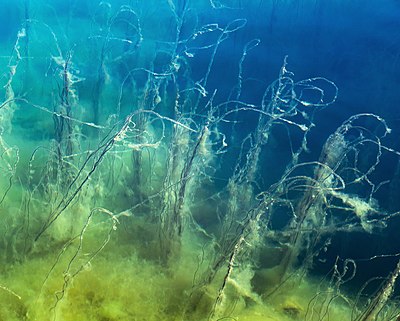
|
Chorda filum, commonly known as dead man's rope and sea lace, among other names, is a species of brown algae in the genus Chorda. It is widespread in the temperate waters of the northern hemisphere, along the coasts of the northern Atlantic and Pacific Oceans. It typically has long, unbranched and hollow rope-like brown fronds about 5 millimetres (0.20 in) in diameter which can reach to lengths of 8 metres (26 ft). The holdfast is disc-shaped and it is found in sheltered marine and bodies of water at depths of 5 metres (16 ft). This photograph depicts long strands of C. filum on an underwater slope in Gullmarn, a fjord in Sweden. Photograph credit: W. Carter
Recently featured: |
December 19
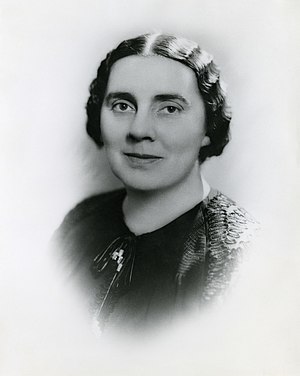
|
Pauline Gracia Beery Mack (December 19, 1891 – October 22, 1974) was an American chemist, home economist, and college administrator. Her research in calcium, nutrition, radiation, and bone density began during the 1930s, and culminated in work for NASA when she was in her seventies. This photograph of Mack, from the archives of the Smithsonian Institution, was probably taken in the early 1940s. Photograph credit: Underwood & Underwood; restored by Adam Cuerden
Recently featured: |
December 20
|
Nanook of the North is a 1922 American silent film written and directed by Robert J. Flaherty, which depicts the life of an Inuit family. From 1910, Flaherty worked for Sir William Mackenzie searching for mineral deposits along the Hudson Bay for the Canadian Northern Railway, and in 1913 he decided to start filming the lands and people of the area, using a glass-plate still camera and movie camera. He then spent 1914 and 1915 shooting hours of film of Inuit life, but his work was lost in 1916 when he dropped a cigarette onto the original camera negative. After four years of raising money, including from French fur company Revillon Frères, Flaherty returned to filming in 1920–21. As a main character, Flaherty chose the hunter Allakariallak. The film was produced in full collaboration with the Inuit. In 1989, Nanook of the North was among the first group of twenty-five films selected by the Library of Congress for preservation in the United States National Film Registry. Film credit: Robert J. Flaherty
Recently featured: |
December 21

|
|
Midvinterblot is an oil-on-canvas painting by the Swedish painter Carl Larsson, created in 1915 for the hall of the central staircase in the Nationalmuseum in Stockholm. It has been called Sweden's most controversial painting. The work depicts a legend from Norse mythology in which the Swedish king Domalde is killed in a sacrifice (blót) to avert famine. After a long debate, the painting was rejected by the museum, but the controversy resurfaced in the late 20th century, and the painting finally was placed where Larsson had intended. Painting credit: Carl Larsson; photograph edited by W. Carter
Recently featured: |
December 22
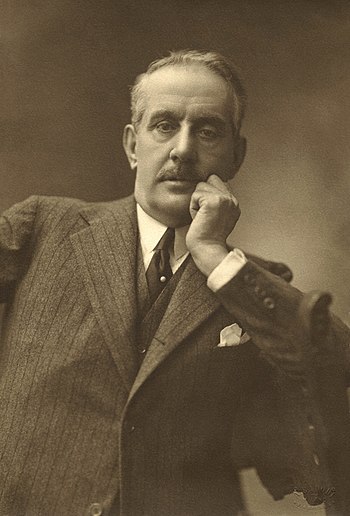
|
Giacomo Puccini (22 December 1858 – 29 November 1924) was an Italian composer known primarily for his operas. Regarded as the greatest and most successful proponent of Italian opera after Giuseppe Verdi, he was descended from a long line of composers, stemming from the late-Baroque era. Though his early work was firmly rooted in traditional late-19th-century Romantic Italian opera he later developed his work in the realistic verismo style, of which he became one of the leading exponents. Photograph credit: Attilio Badodi; restored by Adam Cuerden
Recently featured: |
December 23

|
Constance Baker Motley (1921–2005) was an American jurist and politician who served as a judge of the United States District Court for the Southern District of New York. A key strategist of the civil rights movement, she was a New York state senator and the borough president of Manhattan in New York City before becoming a United States federal judge. She obtained a role with the NAACP Legal Defense and Educational Fund as a staff attorney in 1946 after receiving her law degree, and continued her work with the organization for more than twenty years. She was the first Black woman to argue at the Supreme Court and argued ten landmark civil rights cases, winning nine. She was a law clerk to Thurgood Marshall, aiding him in the case Brown v. Board of Education. Motley was also the first African-American woman appointed to the federal judiciary, serving as a judge for the United States District Court for the Southern District of New York. This photograph shows Motley celebrating her election as the first African-American woman to serve in the New York State Senate in 1964. Photograph credit: Walter Albertin; restored by Adam Cuerden
Recently featured: |
December 24

|
The Three Brothers was a piece of jewellery created in the late 14th century that consisted of three rectangular red spinels arranged around a central diamond. It was known for having been owned by a number of important historical figures. After its commission by John the Fearless, Duke of Burgundy, the Three Brothers was part of the Burgundian crown jewels for almost 100 years before passing into the possession of the German banker Jakob Fugger. The jewel was eventually sold to King Edward VI and became part of the Crown Jewels of England from 1551 to 1643. It was worn prominently by Queen Elizabeth I and King James I. In the early 1640s, Henrietta Maria, the wife of King Charles I, attempted to sell the jewel to raise funds for the English Civil War, but it is unclear if she succeeded. Its whereabouts after 1645 remain unknown. This miniature painting of the Three Brothers, drawn at a scale of 1:1, was commissioned by the city of Basel to serve as an inventory but also as an advertisement to potential buyers around 1500. Painting credit: unknown; photographed by Peter Portner
Recently featured: |
December 25

|
|
Rose O'Neill (1874–1944) was an American cartoonist, illustrator, artist, and writer. Raised in rural Nebraska, she exhibited an interest in the arts at an early age, and sought a career as an illustrator in New York City. Her Kewpie cartoons, which made their debut in a 1909 issue of Ladies' Home Journal, were later manufactured as bisque, composition and celluloid dolls. This chromolithograph by O'Neill, titled "When We All Believe", depicts many children gathered around Santa Claus and his bag of toys, and was published in the December 2, 1903, issue of Puck. Illustration credit: Rose O'Neill; restored by Adam Cuerden
Recently featured: |
December 26

|
|
The green terror (Andinoacara rivulatus) is a colorful species of freshwater fish in the cichlid family, Cichlidae. The fish originates from the Pacific side of South America from the Tumbes River in Peru to the Esmeraldas River in Ecuador. It is polymorphic and can have white or gold-orange edging to the tail and dorsal fins. As its name implies, late juvenile-phase and adult-phase specimens can be very aggressive. This green terror was photographed at Karlsruhe Zoo in Germany. Photograph credit: H. Zell
Recently featured: |
December 27
|
Madama Butterfly is a 1904 opera in three acts by Giacomo Puccini, with an Italian-language libretto written by Luigi Illica and Giuseppe Giacosa. The plot is based on the short story "Madame Butterfly" (1898) by John Luther Long in turn based on stories told to Long by his sister Jennie Correll and on the semi-autobiographical 1887 French novel Madame Chrysanthème by Pierre Loti. The opera features Pinkerton, a U.S. naval officer, who rents a house in Nagasaki, Japan, for himself and Cio-Cio-San (nicknamed Butterfly), a 15-year-old Japanese girl whom he is marrying for convenience and intends to leave once he finds an American wife. This watercolor illustration on cardboard, from the archives of the music publisher Casa Ricordi, depicts the scenic design for a 1906 production Act 1 of Madama Butterfly, set in the hills near Nagasaki. Illustration credit: Alexandre Bailly and Marcel Jambon; restored by Adam Cuerden
Recently featured: |
December 28
Greenbacks were emergency paper currency issued by the United States during the American Civil War that were printed in green on the reverse side. They were in two forms: Demand Notes, issued from 1861 to 1862, and United States Notes, issued from 1862 to 1865. A form of fiat money, the banknotes were legal tender for most purposes and carried varying promises of eventual payment in coin, but were not backed by existing gold or silver reserves. These nine banknotes, part of the National Numismatic Collection at the Smithsonian Institution, form a complete set of the 1862–63 issue of greenbacks. Each bears the signatures of L. E. Chittenden (Register of the Treasury) and F. E. Spinner (Treasurer of the United States), and features an engraving of a prominent individual or other artwork, identified above. Banknote design credit: Bureau of Engraving and Printing; scanned by Andrew Shiva
Recently featured: |
December 29

|
The emu (Dromaius novaehollandiae) is the second-tallest living bird after its ratite relative the ostrich. It is endemic to Australia, where it is the largest native bird and the only extant member of the genus Dromaius. The emu's range covers most of mainland Australia, but the Tasmanian, Kangaroo Island and King Island subspecies became extinct after the European settlement of Australia in 1788. Emus are soft-feathered, brown, flightless birds with long necks and legs, and can reach up to 1.9 metres (6.2 ft) in height. Emus can travel great distances, and when necessary can sprint at 48 kilometres per hour (30 mph); they forage for a variety of plants and insects, but have been known to go for weeks without eating. They drink infrequently, but take in copious amounts of water when the opportunity arises. This emu was photographed in the Tidbinbilla Nature Reserve in the Australian Capital Territory. Photograph credit: John Harrison
Recently featured: |
December 30

|
The Green–Meldrim House is a historic house at 14 West Macon Street, on the northwest corner of Madison Square, in Savannah, Georgia. Built in 1853, it was designated a National Historic Landmark in 1976. The house is owned by the adjacent St. John's Church, which offers tours and uses it as a meeting and reception space. This 1864 sketch by William Waud depicts the entrance hall of the Green–Meldrim House, which was then in use by General William Tecumseh Sherman as his headquarters during the American Civil War. Waud's illustration was adapted into an engraving for the January 21, 1865, issue of Harper's Weekly. Illustration credit: William Waud; restored by Adam Cuerden
Recently featured: |
December 31

|
The Survey of Palestine was the government department responsible for the survey and mapping of Palestine during the period of British Mandatory Palestine. The survey department was established in 1920 in Jaffa, and moved to the outskirts of Tel Aviv in 1931. It established the Palestine grid. In early 1948, the British mandate appointed a temporary director general of the Survey Department for the impending Jewish state; this became the Survey of Israel. The maps produced by the survey have been widely used in "Palestinian refugee cartography" by scholars documenting the 1948 Palestinian exodus, notably in Salman Abu Sitta's Atlas of Palestine and Walid Khalidi's All That Remains. This composite map of the region of Palestine was assembled from twenty-four separate 1:100,000 sheets published by the Survey for Palestine and its successor, the Survey of Israel, between 1942 and 1958. Map credit: Survey of Palestine and the Survey of Israel; assembled by DutchTreat
Recently featured: |
Picture of the day archives and future dates











